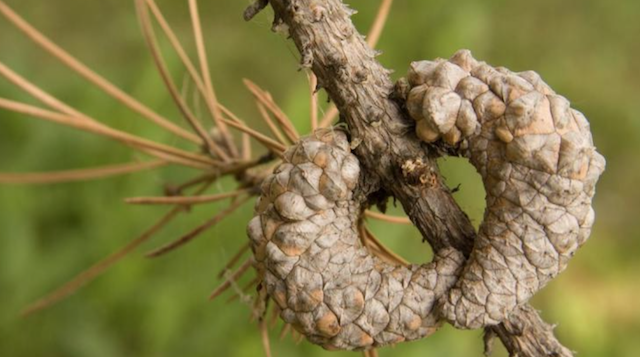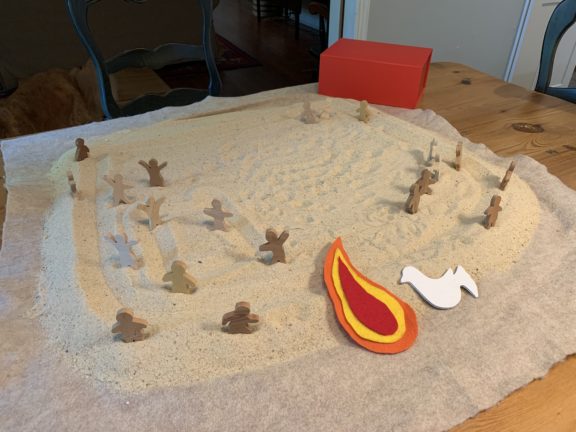
How do Friends experience the fire of the Holy Spirit? What questions and images do we offer in religious education to contemplate the inner Light? How does Pentecost help us to come close to these ideas? Pentecost was absent from my own religious education in an unprogrammed Friends meeting, and it was through work in another church that I came close to this story and found how it resonated for me as a Quaker.
Fire. Light. The Holy Spirit.
These are images from the story of Pentecost that may resonate for us as Friends, particularly when we think about the center of our experiential faith: the Light within, listening for Spirit to guide us. While Friends did not traditionally celebrate religious holidays aligned with the liturgical calendar of the Christian church, Pentecost feels to me like a story our children should hear. As part of their religious formation, young Friends should not only receive information about the story, but there should be opportunities for them to explore where they see themselves in it. How can seeking the Light, receiving gifts of the Spirit, and sharing a message of God’s love for all people across the boundaries of place and language be part of all of our days as Friends?
On the fiftieth day after Easter, the Christian church celebrates the outpouring of the Holy Spirit during Pentecost. Sometimes called “the birthday of the church,” in church Sunday School classes on May 23 this year there will be cupcakes and candles lit to help children connect to that idea. But the story of Pentecost begins with the Jewish festival of Shavu’ot, which is held fifty days after the feast of Passover. (This year, it was observed from sundown on May 16 to the evening of May 18.) During this time in the early first century CE, after the death of Jesus of Nazareth, thousands of people from many lands would have traveled to Jerusalem, bringing harvest to be dedicated in the temple.
It was during the time of Shavu’ot that Jesus’ disciples were also gathered in Jerusalem, obeying the instructions Jesus had given them to wait there for the coming of the Holy Spirit (Acts 1:8). In the Pentecost story, their expectant waiting is interrupted by a sound like a violent wind filling the room, and tongues of fire appeared over the heads of those present, signaling the Holy Spirit’s arrival. The disciples went out into the street and found that they could speak in languages they had not known before. A diverse crowd of visitors to Jerusalem gathered, drawn by the sound of words spoken in their own languages. Jesus’ followers had become messengers. They were no longer disciples, now they were apostles. Young and old, men and women, they were called to something new. They were able to speak to people in languages they had not known before, and they shared Jesus’ message that God’s love is for everyone.
We are also a people spread across the globe speaking many languages and practicing our Quaker faith in different ways. My experience at the FWCC World Gathering in 2016 was one of the Holy Spirit moving among our community of Friends from six continents. Every morning, the regional sections led worship differently — with sermon, song, message, silence, dance — but the common thread of our Quaker faith was also there, weaving through and connecting us. The Bible verse, “My Father’s house has many rooms; if that were not so, would I have told you that I am going there to prepare a place for you?” (John 14:2) had new meaning for me after being among Friends from all over the world. Our practice of the Quaker faith might dwell in different rooms and be shared in various languages, but we are spiritually gathered under one roof as a world family of Friends.
It was teaching Godly Play stories in an Episcopal church that introduced me to Pentecost, where I found how it resonated for me as a Quaker. “The Mystery of Pentecost” story opened for me the experience of the Holy Spirit as fire, which felt deeply connected to images of Light. Around this same time, I found a pinecone charm that I started wearing on a necklace. Curious to know if this natural object had any symbolism or meaning, I learned that serotinous cones spread their seed after fire burns off their resin. They need fire to open them and begin regrowth. I also discovered that pinecones are a frequent image used in church architecture, including in the Vatican. Pinecones have for centuries been a symbol of human enlightenment, resurrection, eternal life and regeneration. As a Friend who identifies as a follower of Jesus’ teachings, the pinecone seed released by fire held a message of resurrection and renewal. What if we taught our children that after Easter comes Pentecost; following the re-affirmation that we can know Jesus in new and evergreen ways, comes the message that we are each called to share our Light in the world through the gifts of the Spirit that we have been given.
What could Pentecost mean today, in this time, for us as Friends? I think of the disciples in the upper room, waiting expectantly for who would arrive and perhaps feeling a little fearful in their isolation and waiting. We have journeyed through a time of isolation, fear, and waiting, too. With the coming of the Holy Spirit, they would cross over into a new time. How might we seek to do things in new ways in coming days? What more inclusive ways of communicating, gathering, and being in community might we discover in the Light? What seeds might the fire we have walked through release?
Resources for exploring the themes of the Pentecost story with children (of all ages):
- Pentecost Labyrinth Coloring Page
- Pentecost Fire Sticks (can be made with ribbon or pipe cleaners)
- The Light of Pentecost — ways to explore the meaning of this day for Friends
- The Day When God Made Church: A Child’s First Book About Pentecost by Rebekah McLeod Hutto
- God’s Big Plan by Elizabeth Caldwell — This vibrant picture book illuminates a new understanding of the story of Babel in Genesis, revealing God’s plan for glorious diversity throughout the world. God’s Big Plan includes a note for parents and educators.
